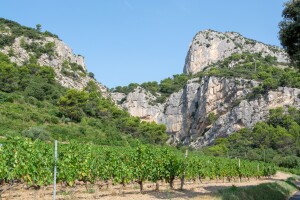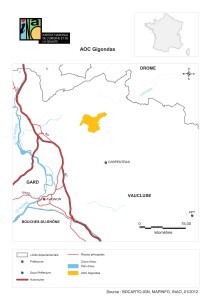Gigondas—located just to the north of Vacquerayas and Beames-de-Venise in France’s Southern Rhône Valley—has historically been known for its cathartic waters (Eau Purgative de Montmirail), its dramatic location at the foot of the jagged mountains of the Dentelles de Montmirail, and its rustic wines (red and rosé) based on Grenache, Syrah, and Mourvèdre.
All of this remains true, but as of the 2023 vintage, Gigondas can boast another claim to fame: white wines! The newly approved Gigondas Blanc designation applies to dry white wines based on the Clairette Blanc grape variety.
- The regulations regarding these wines include the following:
- Principal grape (cépage principal): Clairette Blanc must comprise a minimum of 70% of the blend (many wines may be 100% Clairette)
- Complementary grapes (cépages complémentaires): Bourboulenc, Clairette Rose, Grenache Blanc, Grenache Gris, blanc and gris, Marsanne, Piquepoul, and/or Roussanne may be included up to a maximum of 30% (combined)
- Accessory grapes (cépages accessoires): Viognier and/or Ugni Blanc may be included up to a maximum of 5% (combined)
- Minimum of 12% abv
- Maximum of 3 g/L (approximately 0.3%) residual sugar
White grapes have been grown in Gigondas since antiquity. However, when the original AOC for the region was granted back in 1971, it applied to red and rosé wines only. This meant that any white wine produced from grapes grown in the area would have to be labeled under a more generic appellation, such as the Côtes du Rhône AOC, Côtes du Rhône-Villages AOC, or the Vin de Pays (IGP) Vaucluse.
It is estimated that the region currently has about 16 ha/40 acres dedicated to white grapes, spread out over about 30 different owners. This is certainly a drop-in-the-bucket compared to the region’s 1,180 hectares/2,900 acres of red grapes. However, it is believed that amount of white wine made in the region may soon overshadow the region’s rosé, which currently accounts for a mere 1% of the total production.
The updated Cahier des Charges for the Gigondas AOC was published in the Journal Officiel de la République Française (Official Journal of the Republic of France) on September 23, 2022. Welcome to the world, Gigondas Blanc!
References/for more information:
- https://www.gigondas-vin.com/en/2022/09/15/the-gigondas-appellation-now-applies-to-white-wines/
- Cahier des Charges Gigondas AOC-September 2022
- Avis relatif à l’ouverture d’une procédure nationale d’opposition pour la demande de modification du cahier des charges relatif à l’appellation d’origine contrôlée « Gigondas » – Légifrance (legifrance.gouv.fr)
Post authored by Jane A. Nickles…your blog administrator: jnickles@societyofwineeducators.org


Thank you for keeping us up to date. This is great information!